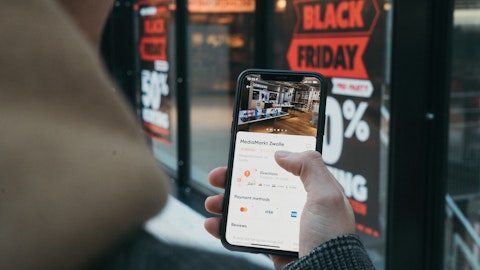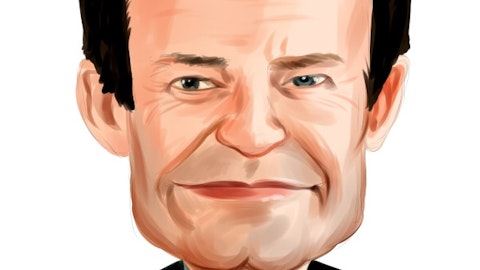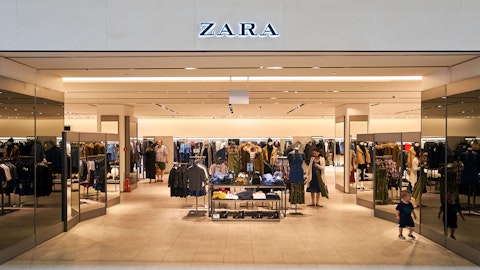The Gap, Inc. (NYSE:GPS) Q3 2022 Earnings Call Transcript November 17, 2022
Operator: Good afternoon, ladies and gentlemen. My name is Brent, and I will be your conference operator today. I would like to welcome everyone to the Gap, Inc. Third Quarter 2022 Earnings Conference Call. At this time, all participants are in a listen-only mode. I would now like to introduce your host, Cammeron McLaughlin, Head of Investor Relations. Cammeron, you may proceed.
Cammeron McLaughlin: Good afternoon, everyone. Welcome to Gap, Inc.’s third quarter fiscal 2022 earnings conference call. Before we begin, I’d like to remind you that the information made available on this webcast and conference call contains forward-looking statements that are subject to risks that could cause our actual results to be materially different. For information on factors that could cause our actual results to differ materially from any forward-looking statements, as well as the description and reconciliation of any financial measures not consistent with Generally Accepted Accounting Principles, please refer to the cautionary statements contained in our latest earnings release, the information included on page two of the slides shown on the Investors section of our website, gapinc.com, which supplement today’s remarks, the risk factors described in the company’s annual report on Form 10-K filed with the Securities and Exchange Commission on March 15th, 2022, and any subsequent filings with the Securities and Exchange Commission, all of which are available on gapinc.com.
These forward-looking statements are based on information as of today, November 17th, 2022 and we assume no obligation to publicly update or revise our forward-looking statements. Joining me on the call today are Interim Chief Executive Officer, Bobby Martin; and Chief Financial Officer, Katrina O’Connell. With that, I’ll turn the call over to Bobby.

https://www.yahoo.com/video/david-tepper-stock-portfolio-top-133736681.html
Bobby Martin: Thank you, Cammeron, and good afternoon, everyone. After four months as Interim President and CEO, I have even deeper conviction that we have a portfolio of iconic brands that our customers love, an increased confidence in our platform to drive leverage and economies of scale, and belief in this team’s ability to deliver. We know where we’ve gotten things wrong and the team and I are at work to correct them. As I told you last quarter, we can and we should win in any environment and the management team and I continue to hold the company accountable to deliver on that. We’ve taken action to optimize profitability and cash flow, while rebalancing and reducing inventory to drive near and long-term improvements across our entire business.
We’ve sharpened our focus on execution or bringing more rigor to our operations and are responding to what our customers are telling us with respect to trend. While our efforts drove sequential improvement during the quarter, our expectations are set on the consistency of execution quarter-after-quarter, year-after-year that we know is crucial to delivering the sustainable profitable growth and value that our people and shareholders expect. Let me provide an update on our progress during the quarter, starting with actions taken on cost. As I last shared, we are aggressively managing costs and have taken the state action in this quarter alone, resulting in roughly $250 million in estimated annualized savings. These actions include; the elimination of 500 existing and open roles in our corporate offices and a pause on hiring and contractor spend for the remainder of the year, resulting in $125 million in estimated annualized savings.
Initially, the renegotiation of our advertising agency contracts, resulting in approximately $75 million in annualized savings; and a reduction in technology, operating costs and rationalized investments, resulting in estimated $50 million of annualized savings beginning in fiscal 2023. We are early in our work here and yet already these savings are expected to help offset higher incentive compensation and increasing labor costs in fiscal 2023. However, there is still work to be done to transform our cost structure and improve overall efficiency, so that we are fit for the future. Next, let me share more on our inventory actions and assortment rebalancing efforts. We continue to rely heavily on markdowns and discounting to sell-through reliable styles this quarter and have reduced receipts in Q4.
These actions will allow us to enter fiscal 2023 in an improved inventory position, and beginning in Q1, our brands will benefit from our reinstated responsive capabilities to chase into product demand. We’re seeing an improved balance in the assortment across the portfolio compared to the first half of the year. And each of our brands were better positioned in the categories that resonate with the base consumer preferences, and our customers rewarded us for that. We saw consistent category strength in dresses, sweaters, pants and woven tops across the portfolio, with active underperforming across the board, as consumers continue to shift away from the cozy at-home lifestyle. While Athleta isn’t immune to the change in consumer preference, despite moderation of growth in the women’s active market, the brand is showing strength in lifestyle categories like dresses and accessories that are demonstrating disproportionate growth in today’s current environment.
Now, let me take a moment and speak to each of our brands, starting with Old Navy. Old Navy delivered net sales growth of 2% over last year, showing early signs of improvement as the brand continues its efforts to right-size inventory, balance assortment, relevance and sizing across its channels. And the brand saw strength in its women’s business in categories including pants, outerwear, sweaters and woven tops. All this was offset, however, by softness in active in kids and baby, as we lapped last year’s strong demand, which we believe was driven in part by the US Child Tax credit and, of course, the heightened post-COVID back-to-school spending. Old Navy customers still have a propensity to buy. That being said, it continues to experience softness in spending and shopping frequency from its lowest income consumers.
As we continue to attract a wide range of consumers, we still believe Old Navy is well positioned in the marketplace, particularly as consumers become more value-conscious. Next, Gap brand. Gap delivered net sales flat to last year and is seeing signs of strength in its core, with a significant shift in trend performance across its women’s business. Iconic Gap store brands who were delivering in trend-right fabrics like faux leather and occasion-based categories like dresses, woven tops, sweaters and pants all drove comparable sales growth. Similar to Old Navy, Gap brand experienced softness in kids and baby and activewear overall. Over the last 18 months, Gap brand has successfully transitioned its France, Italy and UK businesses to franchise partners as part of our Partner to Amplify strategy.
And last week, we signed agreement to transition the Gap Greater China business to Baozun Inc. who will operate our end market sites in stores under a franchise agreement, pending closing conditions and regulatory approval early next year. This strategy allows Gap brand to operate its businesses through a more asset-light, cost-effective model and to benefit from the local expertise of our partners. Moving to Banana Republic, we saw net sales growth of 8% compared to last year. September marked the one-year anniversary of their brand relaunch. Shifting from a highly promotional workwear brand catering to everybody, Banana Republic spent the last year reimagining every element of the customer journey, with a special focus on quality products, differentiated experiences, and relevant branding, positioning it as a premier lifestyle brand that enhances people’s lives wherever they are.
This accessible luxury differentiates Banana Republic from others at this price point and has brought in a more premium consumer. We hope that you’ll take a look soon. During the quarter, Banana Republic experienced strong demand for suiting and its finer fabrics, including silk and cashmere. As post-pandemic consumer preferences began to balance from the current trend of occasion and workwear, it will be important that Banana Republic continues to use its unique customer proposition as a lifestyle brand to differentiate itself for years to come. Finally, on Athleta, Athleta delivered net sales growth of 6% compared to last year. While the women’s activewear market has continued to be soft against the growth trajectory in the past few years, Athleta is holding share.
As I mentioned last quarter, Athleta has made quick pivots to print and pattern as well as with their performance lifestyle product to better meet the customers’ preferences. The new fall and holiday product is resonating well with the customer and Athleta saw growth in both bottoms and tops, the largest categories in the women’s apparel market and key to the brand’s long-term strategy. Before I pass it off to Katrina to share more details on our financials, let me end with how I began on the state of the business. I have no doubt, we have world-class brands that our customers love, and we drive value and scale through the synergy of our platform. But I’m also very clear that there is work to be done to right-size our cost structure, streamline inventory, and capitalize on our creative strengths to deliver the products and experience our customers deserve and employees and shareholders expect.
Lastly, the Board remains active in its search for a permanent Chief Executive Officer. We’re focused on a hands-on leader who can greatly increase our operating rigor, moving us past our deficiencies, while in parallel, enabling strong creative direction and brand architecture as they develop the vision for how our portfolio should evolve over time to create a sustainable business model. This is a great company with strong assets and one that demands a leader who can hold to its value and ensure it remains fit and capable of scaling its omni-platform and market leadership. And with that, I’ll turn the call over to Katrina.
See also David Tepper Stock Portfolio and 15 Biggest Copper Companies in the World.
Katrina O’Connell: Thank you, Bobby and thanks, everyone, for joining us this afternoon. Let me start with our third quarter results. Third quarter net sales of $4.04 billion increased 2% versus last year or 3% on a constant currency basis, driven by an improvement in trend relative to the first half of the year and in part due to the timing of franchise sales. Sales in the third quarter were 1% above pre-pandemic levels in 2019. Comparable sales were up 1% on top of negative 1% comp last year and a significant sequential improvement from the negative 10% comp last quarter, primarily as our assortment rebalancing efforts at Old Navy and Gap are starting to take hold and resonating with our customers as well as the benefit of an early holiday promotional event at Old Navy in October.
Store sales increased 1% from the prior year. Year-to-date, we have closed a net total of 29 Gap and Banana Republic stores in North America and now anticipate closing approximately 30 additional stores this year, bringing us to close to 90% of our goal of closing 350 stores in North America by the end of fiscal 2023. As we look to the remainder of fiscal 2022, we remain on track to open a net 30 Athleta stores and now expect to open a net 10 Old Navy stores this year. Online sales increased 5% versus last year and represented 39% of total sales in the quarter. Compared to pre-pandemic levels in 2019, online sales increased 55%. Turning to sales by brand. Starting with Old Navy, sales in the third quarter of $2.1 billion were up 2% versus last year and increased 10% relative to pre-pandemic levels in 2019.
Old Navy comparable sales were down 1%, representing a sequential improvement from the negative 15% comp last quarter, driven by improvements in category mix and a more balanced assortment that now includes more of the product that our customers have been looking for, as preferences have shifted from cozy casual to work occasion this year. However, we do believe that Old Navy did benefit from a slight pull-forward of sales from the fourth quarter into October, as a result of its efforts to get out earlier than typical with its first holiday promotional event. Gap brand global sales of $1.04 billion were flat versus last year, with global comparable sales up 4%, driven by improved category mix and a more balanced assortment, including more occasion-based and fast and driven categories, as well as comp growth in Asia as a result of lapping the outsized negative impact of COVID-related restrictions last year.
North America comparable sales were flat, a sequential improvement from negative 10% last quarter. Banana Republic sales grew 8% from last year to $517 million, with comparable sales up 10%, as the brand continued to capitalize on the shift in consumer preference and the relaunch and elevated positioning of the brand last year. Athleta sales grew 6% to $340 million, or an increase of 57% compared to 2019 pre-pandemic levels. Comparable sales improved sequentially to a flat comp in the third quarter, compared to negative 8% comp last quarter and negative 7% in the first quarter. As we look to sales in the fourth quarter, we continue to take a prudent approach, given the uncertain macro and consumer environment, as well as the competitive promotional environment.
Also, as stated earlier, third quarter net sales benefited in part by the timing of franchise sales as well as the October holiday event at Old Navy. In addition, Gap brands will be up against an approximate 1 point headwind as we anniversaried Yeezy Gap sales last year that will not be in the base this year. As a result of these factors and the continued uncertain environment, we anticipate that total company sales in the fourth quarter could be down mid-single digits year-over-year. Now, to gross margin. Gross margin in the third quarter was 37.4%, deleveraging 470 basis points versus last year, inclusive of 130 basis points of deleverage related to a $53 million Yeezy Gap impairment charge. On an adjusted basis, gross margin was 38.7%, deleveraging 320 basis points versus last year as we continue to experience higher levels of markdowns in order to better position our inventory.
Excluding the impairment related to Yeezy Gap, merch margin deleveraged 370 basis points as a result of higher discounting due to the previously communicated assortment imbalances as well as more aggressive focus on better positioning and clearing excess inventory as we exit fiscal 2022. Airfreight contributed approximately 200 basis points of leverage as spend levels normalized during the quarter and we lapped the $70 million of incremental air freight expense last year. Equally offsetting this was approximately 200 basis points of deleverage due to inflationary and commodity cost-related headwinds. Turning to ROD. We continue to benefit from our fleet restructuring efforts through lower ROD costs, which were relatively in line with last year on a nominal basis.
Excluding a Yeezy Gap impairment charge, ROD as a percentage of sales leveraged approximately 50 basis points. As we look to gross margin in the fourth quarter, we will lap last year’s $245 million of incremental airfreight, which is expected to add approximately 540 basis points to gross margin versus last year. We continue to anticipate an approximate 200 basis point inflationary and commodity cost headwinds and that ROD will likely be about flat as a percentage of sales versus last year. As we communicated last quarter, while we are taking actions to right-size inventory in an increasingly promotional environment, we continue to expect significant variability in discount rate. As a reminder, gross margin in the second and third quarters were impacted by approximately 370 basis points of deleverage stemming from higher discounting.
Turning to SG&A. Reported SG&A was $1.3 billion or 32.8% of sales, leveraging 540 basis points from the prior year and includes an $83 million net benefit from the sale of our UK DC now that our European partnership model transition is complete. In addition, we recorded an immaterial amount of severance related to the overhead reductions taken in the third quarter. Adjusted SG&A, excluding the UK DC benefit, decreased 5% versus last year to $1.4 billion. As a percentage of sales, adjusted SG&A leveraged 280 basis points from the prior year’s adjusted rate, primarily as a result of higher sales volumes, lower bonus accrual, and lower marketing expense compared to last year. As Bobby discussed, we’ve begun to take actions to right-size our cost structure and improve profitability, focusing acutely on areas where we may have invested without commensurate returns in recent years as it relates to overhead, marketing, and technology.
We’ve already acted on approximately $250 million in annualized savings stemming from the reduction of approximately 500 existing and open corporate roles in the quarter, the renegotiation of advertising agency contracts and the reduction of technology operating costs and rationalization of digital investments. These actions will not have a material impact on SG&A as we look to the fourth quarter as a result of timing and severance offsets, in addition to headwinds in the quarter related to higher seasonal labor costs relative to last year. However, these actions will provide a significant offset to the higher incentive compensation and wage inflation headwinds we anticipate in fiscal 2023. Reported operating income increased 22% to $186 million or 4.6% as a percentage of sales.
Adjusted operating income decreased 8% from the prior year to $156 million. Adjusted operating margin of 3.9% was 40 basis points lower than last year’s adjusted rate, reflecting the elevated promotional activity and higher inflationary costs, offset by the air freight leverage and the SG&A leverage relative to last year. Moving to interest and taxes. We recognized $18 million in net interest expense, a $25 million savings versus last year due to the refinancing of our long-term debt last fall. During the quarter, we recorded an income tax benefit of $114 million on pre-tax income of $168 million, which resulted in a negative effective tax rate of 68%. This income tax benefit was related to the cumulative impact of a change in the estimated annual tax rate as a result of quarterly earnings variability.
This year-to-date tax benefit is expected to reverse and result in at least $200 million of tax expense in the fourth quarter, offsetting the tax benefit on a fiscal year basis. Reported EPS was $0.77. Adjusted EPS, which excludes an approximate $0.18 net benefit related to the UK DC sale and a $0.12 negative impact due to the Yeezy Gap impairment charge was $0.71. Adjusted EPS includes $0.33 related to the tax benefit in the quarter. Share count ended at 365 million. Turning to balance sheet and cash flow, starting with inventory. We are making initial progress on our plan to right-size inventories and move to levels below last year by the end of the fiscal year. Our more aggressive markdowns combined with moderated holiday receipts drove a sequential improvement in the inventory growth during the quarter.
Total ending inventory was up 12% versus last year, a sequential improvement from 37% inventory growth in the second quarter. The 12% year-over-year growth in the third quarter includes a 13 percentage point benefit related to in-transit, as we lapped last year’s supply chain challenges, 9 percentage points of growth related to pack and hold, and close to two-thirds of the remaining increase is attributable to elevated levels of slow-turning basics and the remainder seasonal products. Compared to pre-pandemic levels in the third quarter of 2019, ending inventory was up 12%. While an improvement in trend versus the first half as we expected, we are entering the fourth quarter with overall elevated inventory levels and some carryover of fall product, despite the increased markdown activity in the third quarter.
Although, we did take action earlier this year to reduce holiday receipts, we continue to anticipate a competitive promotional environment, given the increased inventory levels industry-wide and plan to continue to take aggressive action to clear inventory in order to enter fiscal 2023 better positioned. As we look to fiscal 2023, we continue to moderate buys and expect to begin to lean into our responsive levers this spring, which will provide further flexibility to better align inventory levels with demand trends next year. In addition, we are releasing some of last year’s holiday pack and hold inventory, and we’ll continue to integrate our pack and hold inventory into future assortments. As you know, while pack and hold is the use of cash in the short term, we are able to optimize our margin in the near term and benefit working capital next year, as we buy lower receipts and sell through the pack and hold inventory.
Quarter-end cash and equivalents were $679 million. Net cash from operating activities was an inflow of $95 million in the quarter, driven by a moderation in working capital usage as a result of our progress on improving inventory levels and composition coupled with our receipt cuts and leaner buys. As we stated last quarter, we anticipated beginning to see more normalized cash flow in the back half of the year and we are seeing that play out. We continue to focus on fortifying our balance sheet and cash position. As discussed last quarter, we’ve cut or deferred some capital spending and reduced the number of Old Navy stores slated for back half of the year and continue to expect CapEx of approximately $650 million for the year. We remain committed to delivering an attractive quarterly dividend as a core component of total shareholder returns.
During the quarter, we paid a dividend of $0.15 per share, and on November 8th, our Board approved a $0.15 dividend for the fourth quarter of fiscal 2022. We repurchased 1.2 million shares early in the quarter. As discussed last quarter, we have completed our goal of offsetting dilution in fiscal 2022 and do not anticipate repurchasing additional shares this year. We continue to have $476 million available under our current share repurchase program authorization. Before closing, we understand that there has been increased focus on freight and commodity-related tailwinds in fiscal 2023 across the industry as we’ve all begun to see favorability in rates. As a reminder, we have experienced a more modest freight headwind throughout fiscal 2022 as compared to many other retailers as a result of our long-term ocean contracts, which were locked in at favorable rates.
These negotiated rates remain below current ocean container rates. As a result, as ocean container rates come down, this will not represent a significant tailwind to our margin as it may for other retailers as we look to fiscal 2023. In addition, as it relates to cotton and commodity costs, we have already made purchases through the first half of fiscal 2023, and therefore will not begin to benefit from advantaged pricing until we enter the back half of next year. In closing, while we continue to navigate an uncertain consumer environment and promotionally competitive environment, we are confident in the actions we’re taking and believe we are taking the right steps to position Gap Inc. back on its path towards sustainable, profitable growth and delivering value to our shareholders over the long-term.
With that, we’ll open the line for questions. Operator?
Q&A Session
Follow Gap Inc (NYSE:GPS)
Follow Gap Inc (NYSE:GPS)
Operator: Thank you. Our first question comes from Lorraine Hutchinson with Bank of America. Your line is open.
Lorraine Hutchinson: Thank you. Good afternoon. Katrina, thanks for the gross margin puts and takes. I just had a question about the promotional piece of that. You mentioned the 370 in the past two quarters. Just given where your inventories are, where your receipts are in the macro environment, would you expect the promotional pressure to be in line with that or better? Maybe if you could give us some guiderail there? Thank you.
Katrina O’Connell: Yes. Sure, Lorraine, and thanks for the question. I think that’s the real open part of the margin that we sort of left for you to model, giving you guys the known things, which are the airfreight benefit in the quarter for fourth quarter of 540 basis points, partially offset by the inflationary pressure of 200. We’re prepared to keep promoting to get ourselves clean of both fall holiday inventories as we enter into next year. And so, there’s a wide range of possibilities as to what that discount amount could be. I think, if you see Q2 at $370 million and Q3 at $370 million, it’s rational to think that’s a possibility, but we’re not guiding to that number, given there’s such a wide range of possible outcomes. So we’ll let you guys take a look at what you think that will look like, knowing that we will be committed to getting our inventories cleaned up so that we don’t continue to carry the excess inventory into next year.
Lorraine Hutchinson: Thank you. And then related to that, as you look into the first half of next year, what proportion of your inventory will be — will take advantage of some of the responsive capabilities?
Katrina O’Connell: We haven’t said and we’ll certainly consider if we’ll say more on a future call. But I think what’s important to know about responsive, as we’ve said, is that it can take many different formats. So whether it’s getting our basics loaded on to venture managed inventory, which allows us to take advantage of their replenishment capabilities or whether it’s leaving overall inventory open to chase in history fees, or just give us an ability to range up or range down total inventory based on demand, it really is a capability that we’re looking forward to having back. With the manufacturing disruption that we saw starting with India closing and then Vietnam closing and many of the other jurisdictions closing down during COVID, we really lost those capabilities, which caused us to have to lean too far forward into total inventory as well as category inventory.
And so, having those levers back will give us so much more flexibility. But we haven’t said it’s different by brand, and certainly, we’re happy to talk more about it as we get closer in, if appropriate.
Lorraine Hutchinson: Thank you.
Operator: Your next question is from the line of Bob Drbul with Guggenheim. Your line is open.





